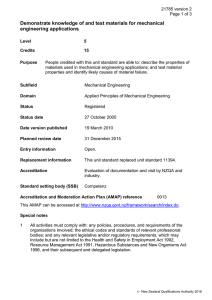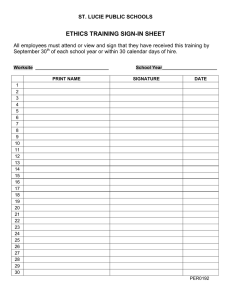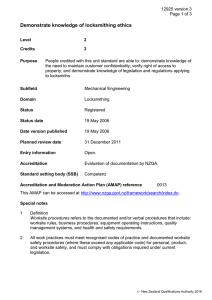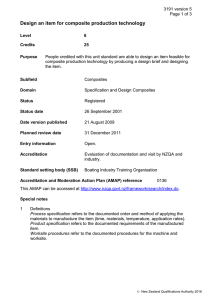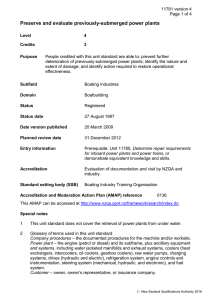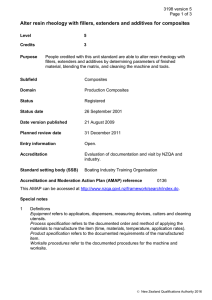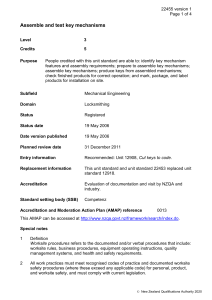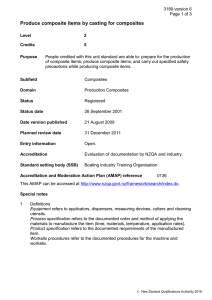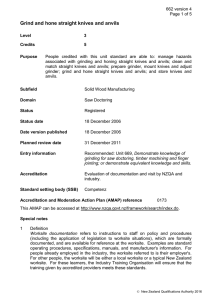Demonstrate knowledge of saw grinder application and operation
advertisement
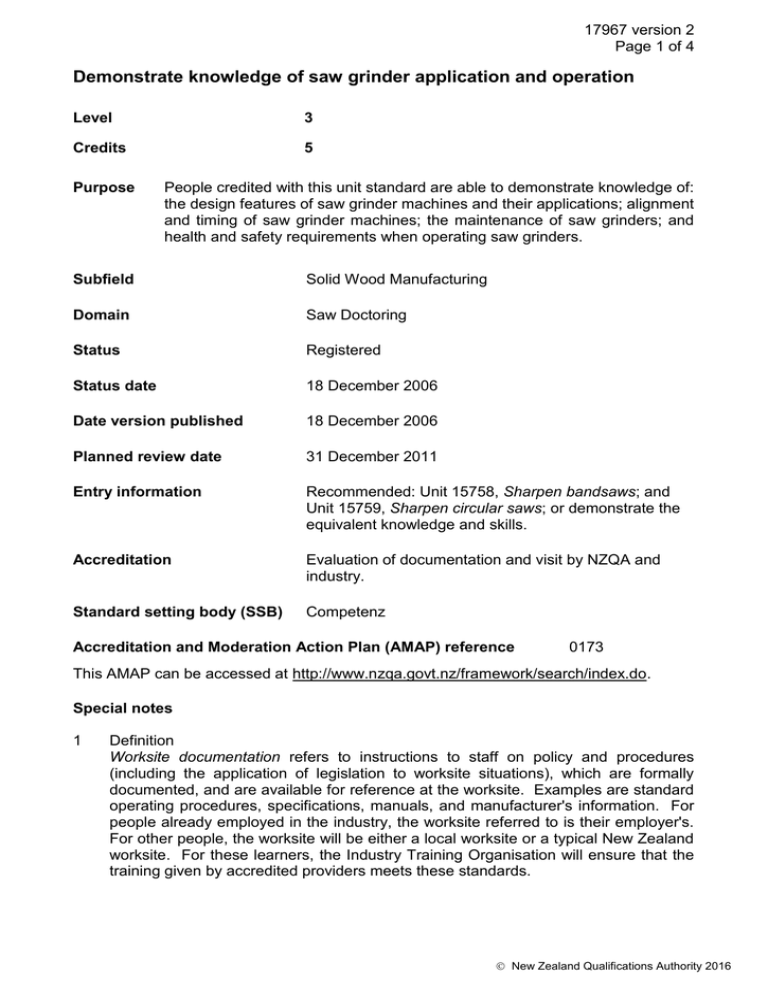
17967 version 2 Page 1 of 4 Demonstrate knowledge of saw grinder application and operation Level 3 Credits 5 Purpose People credited with this unit standard are able to demonstrate knowledge of: the design features of saw grinder machines and their applications; alignment and timing of saw grinder machines; the maintenance of saw grinders; and health and safety requirements when operating saw grinders. Subfield Solid Wood Manufacturing Domain Saw Doctoring Status Registered Status date 18 December 2006 Date version published 18 December 2006 Planned review date 31 December 2011 Entry information Recommended: Unit 15758, Sharpen bandsaws; and Unit 15759, Sharpen circular saws; or demonstrate the equivalent knowledge and skills. Accreditation Evaluation of documentation and visit by NZQA and industry. Standard setting body (SSB) Competenz Accreditation and Moderation Action Plan (AMAP) reference 0173 This AMAP can be accessed at http://www.nzqa.govt.nz/framework/search/index.do. Special notes 1 Definition Worksite documentation refers to instructions to staff on policy and procedures (including the application of legislation to worksite situations), which are formally documented, and are available for reference at the worksite. Examples are standard operating procedures, specifications, manuals, and manufacturer's information. For people already employed in the industry, the worksite referred to is their employer's. For other people, the worksite will be either a local worksite or a typical New Zealand worksite. For these learners, the Industry Training Organisation will ensure that the training given by accredited providers meets these standards. New Zealand Qualifications Authority 2016 17967 version 2 Page 2 of 4 2 Legislation relevant to this unit standard includes but is not limited to the Health and Safety in Employment Act 1992 and its subsequent amendments. Elements and performance criteria Element 1 Demonstrate knowledge of the design features of saw grinder machines and their applications. Performance criteria 1.1 Grinding machine design features are explained. Range 1.2 Types of grinding methods are explained and their advantages and disadvantages described. Range 1.3 plunge and profile grinders. wet and dry grinding, plunge and profile grinders. Saws are identified and matched with selected saw grinding machine types. Element 2 Demonstrate knowledge of alignment and timing of saw grinder machines. Performance criteria 2.1 Procedures for aligning components of saw grinder machines are explained in accordance with stipulated requirements. Range 2.2 – manufacturer’s Timing principles for plunge and profile grinders are identified and explained in accordance with stipulated requirements. Range 2.3 may include but is not limited to recommendations, worksite documentation. may include but is not limited to recommendations, worksite documentation. – manufacturer’s Principles for obtaining full backed tooth profiles are explained in accordance with worksite documentation. New Zealand Qualifications Authority 2016 17967 version 2 Page 3 of 4 Element 3 Demonstrate knowledge of the maintenance of saw grinders. Performance criteria 3.1 Methods required for maintaining grinders in good working order are described and are consistent with worksite documentation. Range may include but is not limited to – regular cleaning and inspection, checking for defects and faults, coolant ratios. 3.2 Parts and components that wear are identified and maintenance procedures are explained in terms of wet and dry applications. 3.3 Effects of worn parts on grinder machine performance and alignment are explained. Range 3.4 may include but is not limited to – faceplate, cone screws, feed fingers, bearings, saw support system. Machine maintenance schedule requirements are explained in terms of manufacturer’s recommendations and worksite documentation. Element 4 Demonstrate knowledge of health and safety requirements when operating saw grinders. Performance criteria 4.1 Safety procedures are described in relation to site specific requirements and legislative obligations. Range personal protective equipment, worksite safety requirements, Material Safety Data Sheets (MSDS). Please note Providers must be accredited by the Qualifications Authority, or an inter-institutional body with delegated authority for quality assurance, before they can report credits from assessment against unit standards or deliver courses of study leading to that assessment. Industry Training Organisations must be accredited by the Qualifications Authority before they can register credits from assessment against unit standards. Accredited providers and Industry Training Organisations assessing against unit standards must engage with the moderation system that applies to those standards. New Zealand Qualifications Authority 2016 17967 version 2 Page 4 of 4 Accreditation requirements and an outline of the moderation system that applies to this standard are outlined in the Accreditation and Moderation Action Plan (AMAP). The AMAP also includes useful information about special requirements for organisations wishing to develop education and training programmes, such as minimum qualifications for tutors and assessors, and special resource requirements. Comments on this unit standard Please contact the Competenz at info@competenz.org.nz if you wish to suggest changes to the content of this unit standard. New Zealand Qualifications Authority 2016

